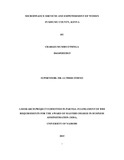| dc.description.abstract | Seventy percent of the world‘s poor are women. Yet traditionally women have been
disadvantaged in access to credit and other financial services. Commercial banks often focus on
men and formal businesses, neglecting the women who make up a large and growing segment of
the informal economy. Microfinance institutions on the other hand often targets women, in some
cases exclusively. Female clients represent eighty-five percent of the poorest microfinance
clients reached. Empowerment refers to increased well-being, community development, selfsufficiency
and expansion of individual choice.
Bisnath and Elson (1999) state that microfinance typically focuses on women‘s individual
aspects, such as engagement in economic activities, productivity and individual choice, at the
expense of empowerment through changes in power structures and gender relations. This
emphasis on the individual aspects in turn makes empowerment merely an instrument in
achieving economic development.
The objective of the study was to establish the extent to which microfinance services have
empowered women, and to determine factors that influence women to go for microfinance
services rather than those of mainstream banks. Cross sectional survey method was employed in
this study. The study population consisted of clients of five main microfinance institutions
operating in Kisumu County. The study adopted systematic random sampling method of a
sample size of 60 clients from the five MFIs. The researcher used primary data. Primary data was
collected through the use of structured and semi-structures questionnaires. Quantitative data was
analyzed using descriptive and inferential statistics.
The study found that MFIs prefer to deal with groups to individuals. Women are good in making
and staying in groups, whether for social or financial reasons. Therefore, women‘s ability to
mobilize themselves in groups has seen them edge out men and the youth from the institutions
that target small-scale traders. Being in a group demands that one should attend meetings every
week and make contributions and when one is in need of a loan, the group will act as the
guarantors.
However the study also found that there are many challenges facing microfinance industry in the
country such as: high cost of service delivery with poor infrastructure, regulatory policy issues
and the need to develop institutional leadership. Some women access credit, but only to pass it
onto others who are not directly accountable, leaving them with the loan repayment burden. The
one year repayment period is one of the reasons for the default in repayments. Examples of such
failure make other women reluctant to borrow. Because of the society‘s perception of a woman‘s
place in the home, some women are not aware of the existence of sources of finance | en_US |

